 SentinelRework_And_Heartseeker_Header1920×622 295 KB
SentinelRework_And_Heartseeker_Header1920×622 295 KB
Hello Travelers, and welcome back to the Pre-Patch Hype Week Blog Posts #2! In today’s blog post, we’re covering the complete Sentinel rework and the new skill for the Rogue Marksman: Heartseeker! We will start with the Heartseeker, and save the bigger dive into the Sentinel for the latter portion of this post. If you missed the first installment of our Hype Week Blog Posts, you can see #1 right here: The Woven Faction & Monolith Updates | Coming to Last Epoch April 17th
With us covering a new skill, a completely reworked skill, passive skill changes, and other skill changes, we find ourselves with a decently long post. Take a look at the linked table of contents to help you navigate, and enjoy this longer Pre-Patch Hype Week Blog Post.
Go to Comments
Table of Contents
Heartseeker
| Heartseeker |
| Shadow Weaver’s Grasp |
| Arrow of the Ravager |
| Nimble Threads |
| Heartdrain |
| Exposed |
| Damage Conversion |
| Going Even Further Beyond |
Sentinel Rework
| Intro |
| Volatile Reversal |
| Nether Convergence |
| Future Focus |
| Reclaimed Action |
| Void Bolts |
| Holding the Line |
| Anchored Timeline |
| And More |
| Symbols of Hope |
| Time Rot |
| Other Changes |
| Forgemaster’s Might |
| Sword of Rahyeh |
| Holy Precision |
| Woe |
| Abyssal Fluctuation |
| Intro |
| Devouring Orb |
| Javelin |
| Multistrike |
| Shield Throw |
| Smelter’s Wrath |
| Vengeance |
| Closing |
Go to Comments
Heartseeker
With Detonating Arrow, Multishot, and Hail of Arrows, the Marksman mastery covers area of effect style attacks fairly well, however this has presented an opening for a skill featuring high single target damage. Introducing Heartseeker. Launching a ranged projectile with the ability to recurve to the same target repeatedly, Heartseeker is highly capable in both Hit and DoT style builds to bring high-health targets to their knees. Becoming available with 30 points spent in the Marksman tree, this puts Heartseeker beyond the “chain lock”, making this new skill exclusive to the Marksman Mastery.
/uploads/default/original/3X/4/a/4af0b8500b569e261554d64650c204a3c90b0ea7.mp4With Heartseeker, you will find a new mechanic in Last Epoch: Recurve Chance. Recurve works differently from other repeating attacks, such as Shield Throw’s Ricochets or Shuriken’s Pierces. In these examples, you increase the number of effective hits with a flat increase, such as +2 Ricochets, whereas with Heartseeker, you’ll have a Recurve chance.
 heartseeker3840×2170 3.26 MB
heartseeker3840×2170 3.26 MB
Shoot an arrow that seeks the heart of a nearby target, passing harmlessly through other enemies. Whenever it hits its target it has a chance to continue through it and Recurve to strike it again. Subsequent Recurve chance is multiplied by 0.8 each time the arrow Recurves. If the target dies, it will choose a new target.
Starting with a default 100% Recurve Chance, each time Heartseeker strikes an enemy, its Recurve chance is multiplied by 0.8. This means at a baseline, it will always Recurve once, an 80% chance for a second Recurve, 64% for a third Recurve, and so on, until it fails to roll within the remaining percent chance. By increasing the Recurve chance, the minimum amount of Recurves each use of the skill will also increase. For example, with 125% Recurve Chance, it’s guaranteed to Recurve at least two times from the default one, and at 157% Recurve Chance, it’s guaranteed to Recurve at least three times. One node in particular can allow a Heartseeker projectile to ‘theoretically’ continually Recurve until it no longer has any targets remaining.
Specialization
As with all skills in Last Epoch, Heartseeker comes with a full skill tree, allowing you to specialize the skill extensively. Not limited to simple number changes, you can change its behavior to emphasize the exact role you’re looking for the skill to fulfill: focus on Recurve Chance to maximize the number of repeated hits, trigger Puncture to “share the love” with other enemies, or a combination of the above.
Shadow Weaver’s Grasp
 shadowweaversgrasp1920×1076 81 KB
shadowweaversgrasp1920×1076 81 KB
With Shadow Weaver’s Grasp, your Recurve chance will never drop below 66%. This means every time Heartseeker strikes an enemy, there’s a 66% chance that it will continue into another Recurve, then another, then another. With no limit to how many times Heartseeker can theoretically Recurve, this makes for a fun node for those that like their odds.
Arrow of the Ravager
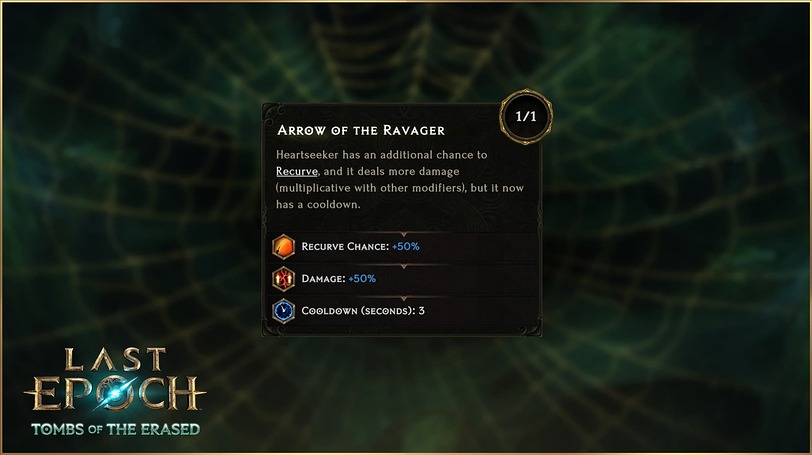 arrowoftheravager1920×1076 85.2 KB
arrowoftheravager1920×1076 85.2 KB
Looking for a Heartseeker that’s a bit more tactical in use rather than spam? Arrow of the Ravager offers a large amount of both Recurve chance, and damage multiplier at the cost of adding a cooldown to Heartseeker, which can be reduced with Increased Cooldown Recovery Speed. Behind this node, you’ll also find nodes to provide additional charges, and refresh a charge when you pick up a Black Arrow.
Nimble Threads
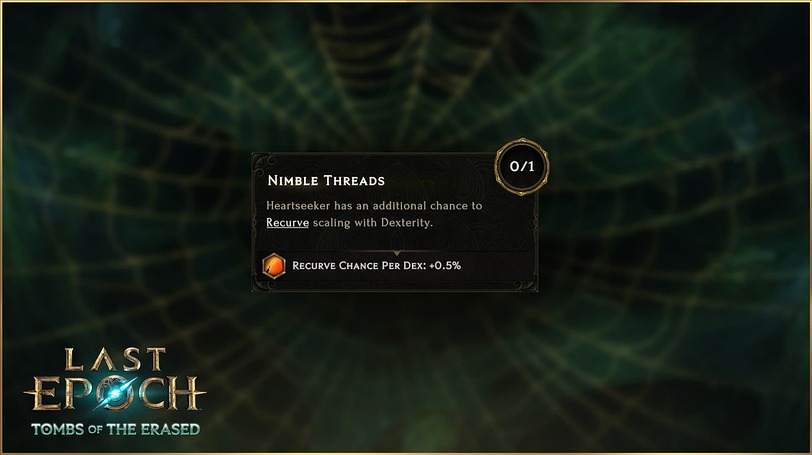 nimblethreads1920×1076 75.3 KB
nimblethreads1920×1076 75.3 KB
With Nimble Threads you’ll be able to acquire a scaling source of Recurve chance through stacking Dexterity - a valuable attribute for almost any Rogue.
Heartdrain
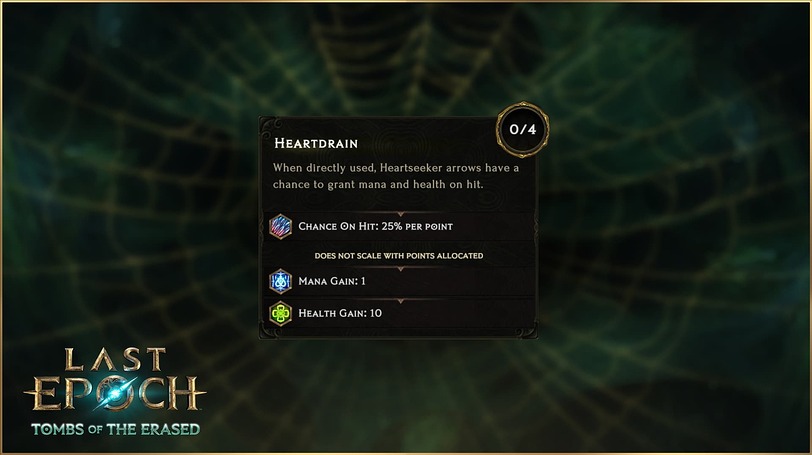 heartdrain1920×1076 83 KB
heartdrain1920×1076 83 KB
How about turning Heartseeker into a generator and support skill? Stack Recurve chance with Heartdrain, and quickly watch the mana and health roll in.
Exposed
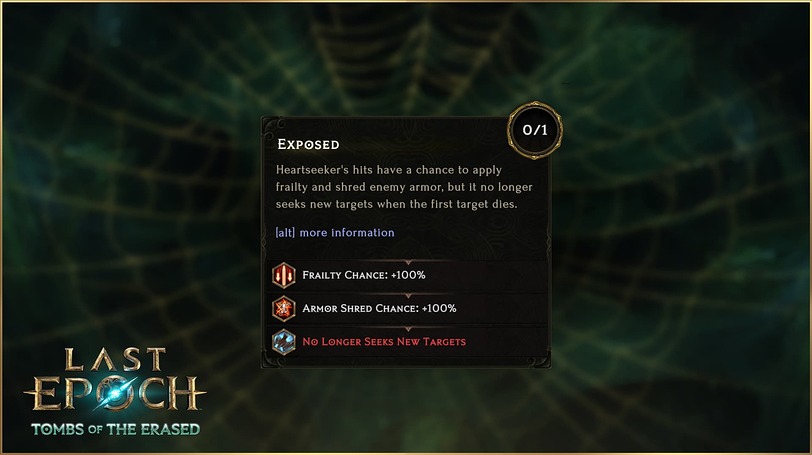 exposed1920×1076 89.9 KB
exposed1920×1076 89.9 KB
With Exposed, Heartseeker changes its behavior to only Recurve back to the same target. The perfect option for a bit of ranged assassination as Heartseeker will also harmlessly pass through any enemies aside from the target.
 straightthrough1920×1076 80.7 KB
straightthrough1920×1076 80.7 KB
Behind Exposed, you will also find Straight Through. Where Exposed focuses Heartseeker onto a single target, Straight Through makes sure any leftover recurves aren’t left to waste and are instead converted into Punctures fired at nearby enemies.
Damage Conversion
Heartseeker is a Physical Bow Attack by default, however its tree offers options to convert to either Fire or Cold; each with its own scaling options.
 frozensplinter1920×1076 81.3 KB
frozensplinter1920×1076 81.3 KB
Converting to Cold damage will grant access to Frozen Splinter, granting scaling Cold Penetration based on Overcapped Cold Resistance. Powerful with both hit and Frostbite builds, you can never go wrong with Damage Penetration. Being a scaling source means your equipment matters that much more to get the most out of this node.
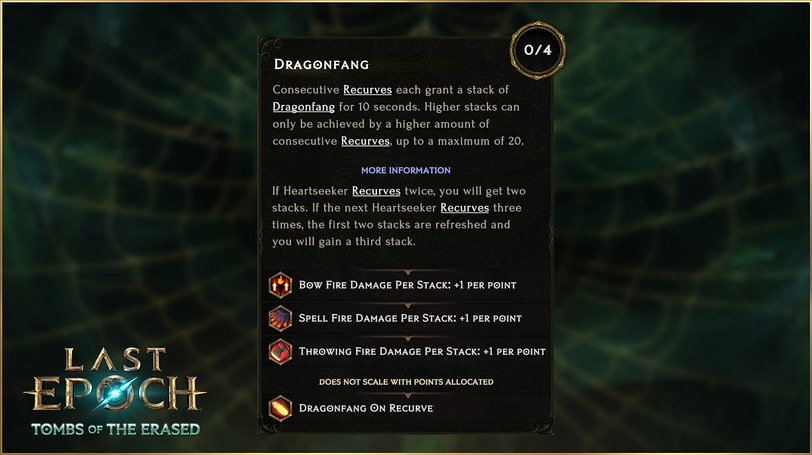 dragonfang1920×1076 108 KB
dragonfang1920×1076 108 KB
Alternatively, convert Heartseeker to Fire and gain access to Dragonfang, offering stacking added fire damage for Bow, Spell, and Throwing attacks. Dragonfang is a buff rather than a skill modifier, this means all Bow, Spell, or Throwing damage you deal will benefit from this added damage. However be aware, only the highest Recurve count matters: You can’t simply stack attack speed to get the most out of this node, you need individual Heartseekers to Recurve repeatedly to grant higher stack counts of DragonFang, potentially up to 20 stacks for a total of 80 added Bow, Spell and Throwing Fire damage.
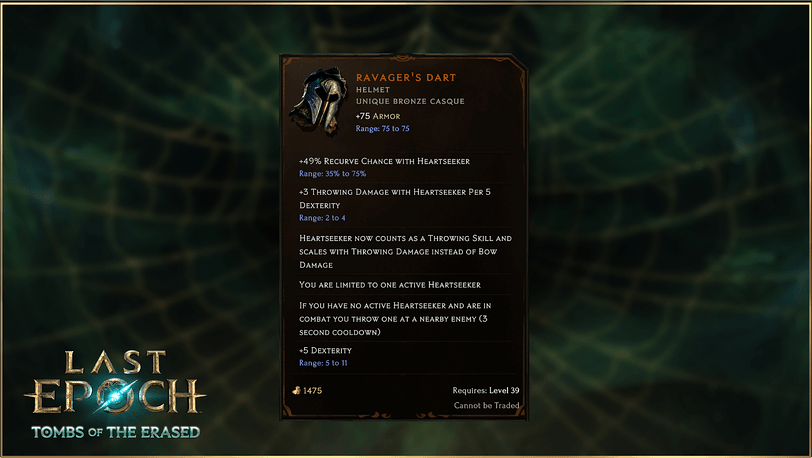 ravagersdart3840×2170 3.12 MB
ravagersdart3840×2170 3.12 MB
Speaking of throwing, let’s not forget that the Skill Tree isn’t the only way to modify a Skill in Last Epoch. One of the new Unique Items you’ll be able to find in Season 2 is the new Ravager’s Dart helm. This Unique item fundamentally changes Heartseeker from a Bow attack to a Throwing attack, and offers a number of other bonuses at the cost of limiting you to one active Heartseeker at a time.
Going Even Further Beyond
Of course, Heartseeker isn’t limited to the above modifiers. You’ll find other nodes within Heartseeker which allow it to consume Shadows for extra Heartseeker attacks, have Heartseekers drop Black Arrows, and of course nodes that offer Bleed Chance, Poison Chance, Critical Strike Chance and Multiplier, as well as other stacking Recurve bonuses.
In Season 2, the Rogue comes to the party with a brand new way to make enemies feel the pain and fear the shadows. How many times do you think you’ll be able to get a Heartseeker to Recurve?
Sentinel Rework
Alongside Heartseeker, a second reworked and essentially new skill will be making its debut in Season 2: Volatile Reversal. This bears some reasoning, as neither Sentinel nor Volatile Reversal has been unpopular. In fact, Volatile Reversal has been very popular but not for a good reason.
The current version of Volatile Reversal offers very powerful global bonuses and, as such, has been a mainstay in almost every Sentinel build. While having a supporting ability certainly isn’t problematic, Volatile Reversal features a very unique mechanic, relocating the player back in time. With the skill being used for its passive global bonuses rather than its mechanical effects, this left the skill in an unhealthy position where it felt necessary to many players due to the strength, yet at the same time was often unfun, or “annoying” to use as players just wanted the buffs, and not to be moved back in time.
Because of this, we’ve intended to rework Volatile Reversal for some time. However, with Sentinel being almost “propped up” by Volatile Reversal, reworking it to be a more individually interesting skill rather than an unfun support buff would leave many Sentinel options in too weak of a place. Thus, with Season 2, we’re both reworking Volatile Reversal into a new skill, with an entirely new Skill Tree and mechanics, as well as providing many buffs and changes across many Sentinel skills and passives to help Sentinels Eterra-wide stand on their own without leaning heavily on a single skill.
Volatile Reversal
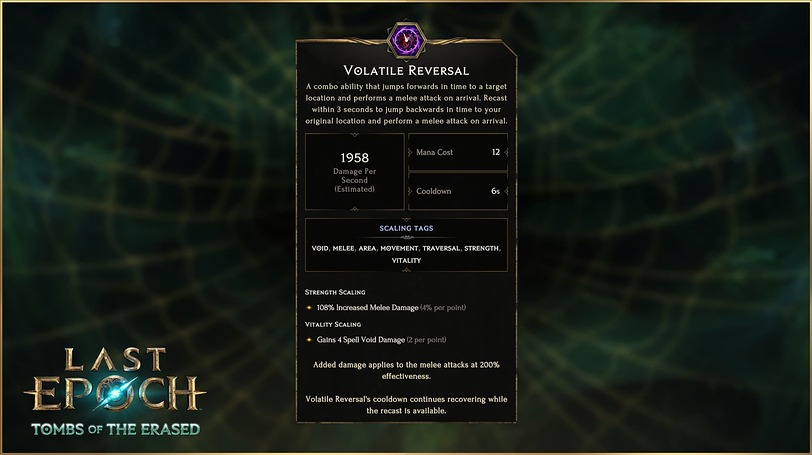 volatilereversal1920×1076 100 KB
volatilereversal1920×1076 100 KB
A combo ability that jumps forwards in time to a target location and performs a melee attack on arrival. Recast within 3 seconds to jump backwards in time to your original location and perform a melee attack on arrival.
Rather than being a supporting spell, Volatile Reversal is making its grand reappearance as a Melee Traversal Combo skill. As a two-part combo skill, Volatile Reversal allows you to teleport into enemies, landing an area melee attack and allowing for further follow-up before re-activating and teleporting back in time to your original location. Or, if you’re happy with the engagement, simply don’t reactivate the skill and retain your all-new forward-future self (Effects on aging of Travelers from not returning unknown)
/uploads/default/original/3X/d/f/dfa4f5d2ffa385fb28d0f279f6552137ec47bac5.mp4Providing both engagement and disengagement in one skill, Volatile Reversal offers new engagement opportunities to Sentinels and new synergies and build options. While it may be noticed that the skill offers Added Void Spell Damage through Vitality scaling, the skill only deals melee damage by default, and this Vitality scaling is offered for optional spell-based subskills in the Skill Tree. Becoming available with five points spent in the Void Knight tree, this places Volatile Reversal before the “lock line”, making it available to all Sentinels with the right investment.
Specialization
Volatile Reversal also offers its own full Skill Tree to customize how you want to utilize it in your build. Make it a high-damage engagement option, maximize its traversal potential, or support other skills to further expand their potential.
Nether Convergence
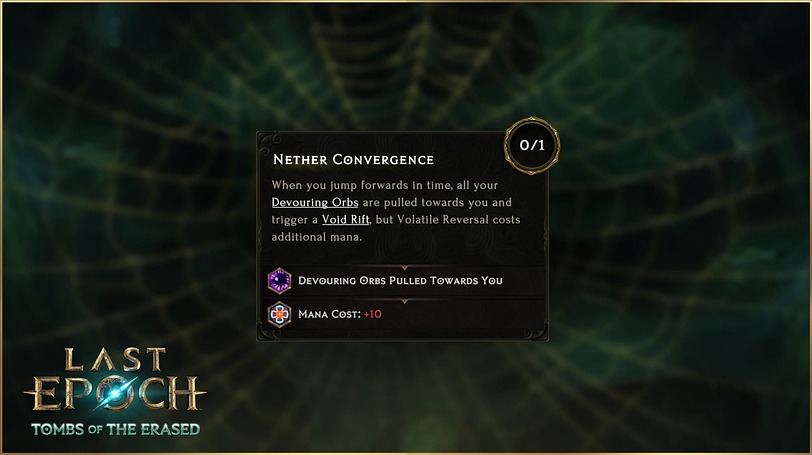 netherconvergence1920×1076 86.6 KB
netherconvergence1920×1076 86.6 KB
With Nether Convergence, Volatile Reversal supports your Devouring Orbs by pulling them toward you every time you jump forward. Why cast new Devouring Orbs when you have perfectly good Orbs on the field already? Bring them along on a field trip.
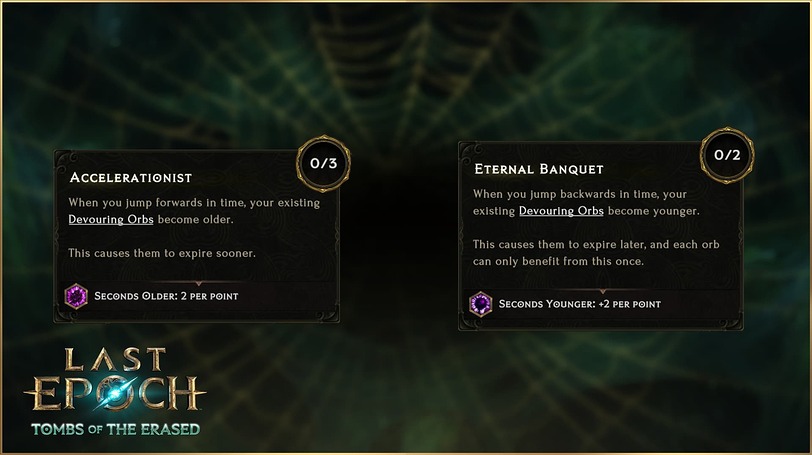 accelerationist1920×1076 99.1 KB
accelerationist1920×1076 99.1 KB
While Nether Convergence pulls your Devouring Orbs along with you, Accelerationist or Eternal Banquet can either cause your Orbs to expire earlier or last longer, at will, augmenting how you’ve built Devouring Orb.
Future Focus
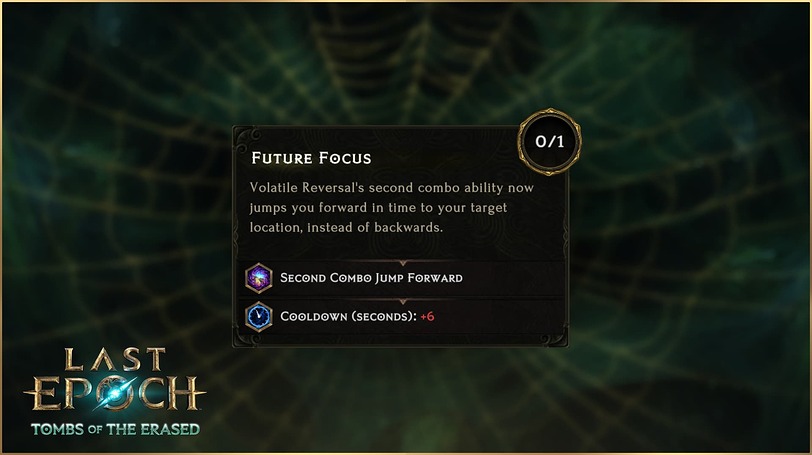 futurefocus1920×1076 87.3 KB
futurefocus1920×1076 87.3 KB
Does your Sentinel only look to the future? With Future Focus, the second activation of Volatile Reversal will now send you forward a second time, allowing greater forward mobility at the cost of a longer cooldown.
Reclaimed Action
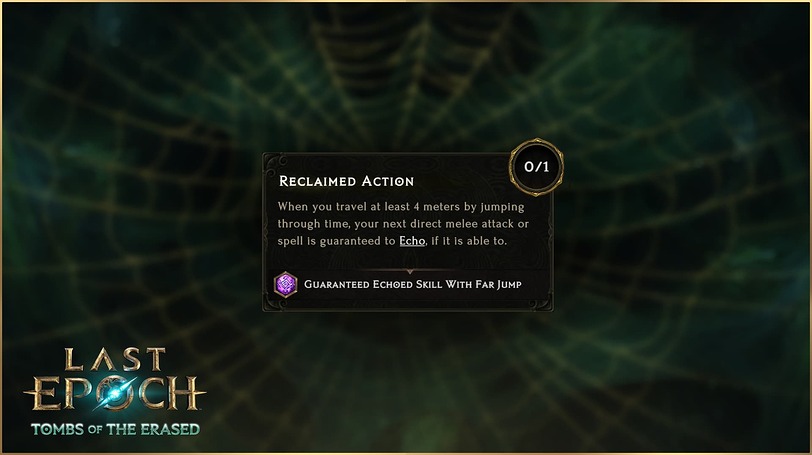 reclaimedaction1920×1076 83 KB
reclaimedaction1920×1076 83 KB
What’s a Void Knight without Echoes? Reclaimed Action guarantees your next direct melee attack or spell Echoes so long as you traveled at least four meters - a great addition with any heavy-hitting build to really bring the pain with the initial engagement.
Void Bolts
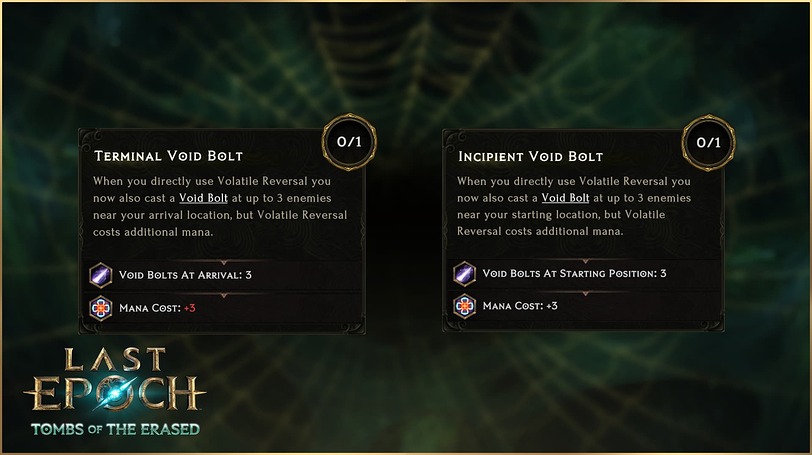 terminalvoidbolt1920×1076 108 KB
terminalvoidbolt1920×1076 108 KB
As mentioned earlier, Volatile Reversal can also be specialized toward spell damage. You can do this in Void Bolts with both Incipient Void Bolt and Terminal Void Bolt. These options will launch a set of three Void Bolts at the start of movement and end to barrage enemies with Void damage.
 returningcorruption1920×1076 90.7 KB
returningcorruption1920×1076 90.7 KB
Add Returning Corruption to cause all Void Bolts to return, and double down on the delivery. These nodes apply to each activation of Volatile Reversal, meaning if you pick up both Incipient and Terminal Void Bolts, you’ll trigger a total of six projectiles per cooldown.
Holding the Line
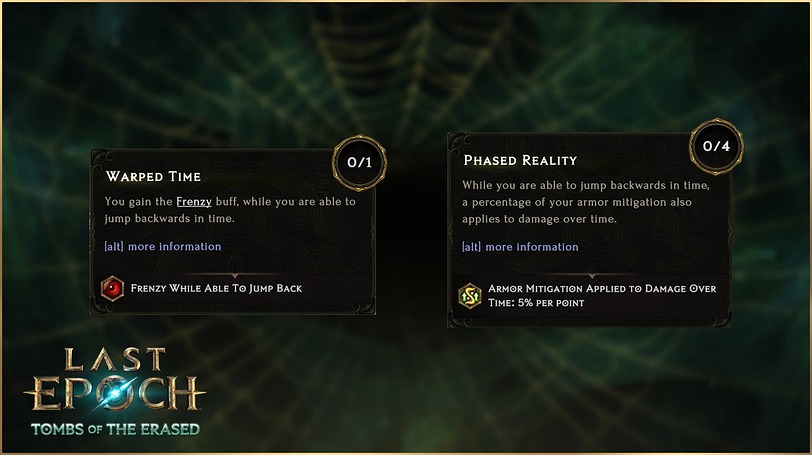 warpedtime1920×1076 99.3 KB
warpedtime1920×1076 99.3 KB
Of course, there’s always the option of specializing in Volatile Reversal into more of a support role. With Warped Time and Phased Reality, you can gain powerful buffs after jumping into the fray - for so long as you hold off on jumping back out.
Anchored Timeline
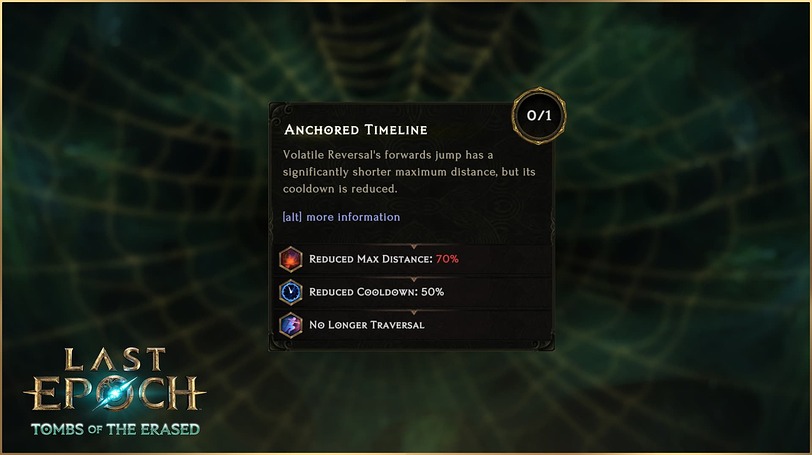 anchoredtimeline1920×1076 85.6 KB
anchoredtimeline1920×1076 85.6 KB
Perhaps you’d rather have Volatile Reversal as more of an offensive ability with a shorter cooldown? At the cost of making the skill less mobile, you’ll be able to cut the base cooldown in half and remove the Traversal Tag, allowing for much more frequent use, particularly when stacked with additional sources of Increased Cooldown Recovery Speed.
And More
In addition to the mentioned nodes, you’ll also find options that allow you to convert Volatile Reversal to Fire Damage, grant Void Essence, Trigger Abyssal Echoes, or increase the damage options for Volatile Reversal itself. The new Volatile Reversal offers a completely new playstyle option and many new build opportunities with it.
Sentinel Changes
While Volatile Reversal may have the spotlight for the Sentinel Rework, as mentioned, there’s a whole lot of other changes coming to the class with this update in both Skills and Passives. Let’s start taking a look at some of these with one of the more significant changes: Symbols of Hope.
Symbols of Hope
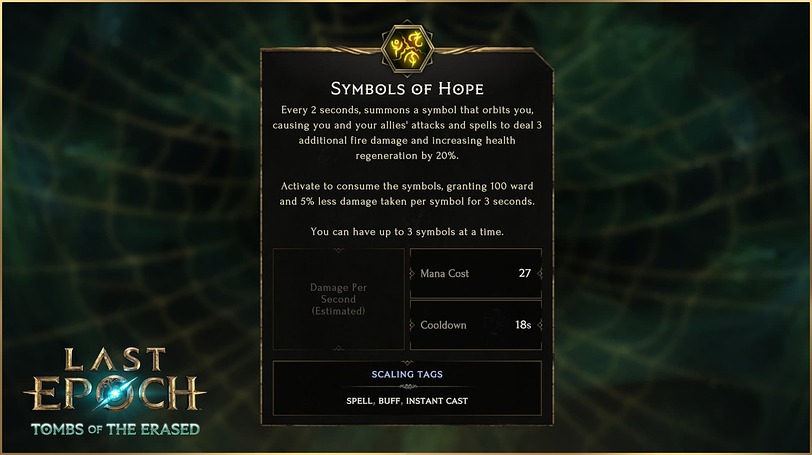 symbolsofhope1920×1076 99.4 KB
symbolsofhope1920×1076 99.4 KB
But wait, isn’t the skill called “Sigils of Hope?” Not as of Season 2! In the future, we will be adding the Sigils system, which left a bit of confusion with this skill. With the mechanical changes, we felt there was no better opportunity to resolve that confusion with a small name change. The mechanical change, not so small.
Every 2 seconds, summons a symbol that orbits you, causing you and your allies’ attacks and spells to deal 3 additional fire damage and increasing health regeneration by 20%. Activate to consume the symbols, granting 100 ward and 5% less damage taken per symbol for 3 seconds. You can have up to 3 symbols at a time.
Like Volatile Reversal, Sigils of Hope often became an “annoying” factor. As a buff skill that required regular reactivation to maintain passive bonuses, it ended up either being an interruption to play without a fun effect or simply being auto-cast. Rather than gaining a Sigil upon using the ability, the change to Symbols of Hope now causes the player to gain Symbols passively over time, while activating the skill will consume the Symbols for significant temporary buffs.
While not a fully reworked skill like Volatile Reversal, you’ll still find many differences in the new Symbols of Hope tree, including a changed Divine Flare branch, Ward Generation, and new passive bonuses, such as Increased Critical Strike Chance.
Orian’s Sun Seal
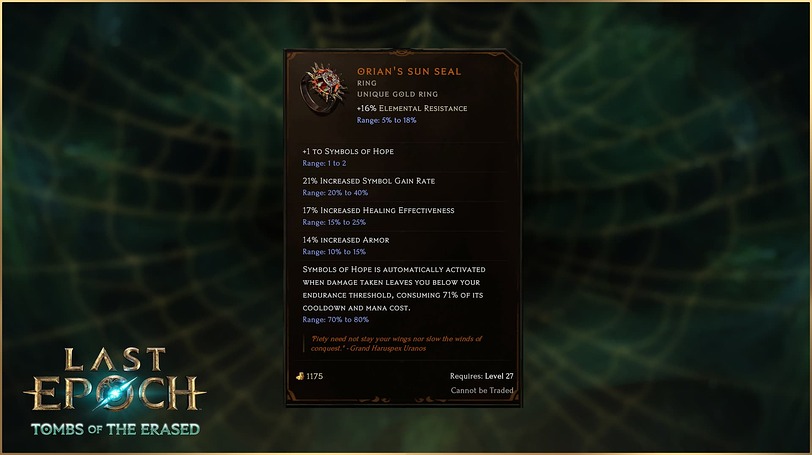 orianssunseal1920×1076 95.5 KB
orianssunseal1920×1076 95.5 KB
Of course, passively generating Sigils was previously the domain of the Unique item: Orian’s Sun Seal. This leaves many asking, “What does this Unique do now?” The answer: Orian’s Sun Seal now increases the rate you passively gain Symbols and offers a circuit breaker activating Symbols of Hope when you’re left below your Endurance Threshold to automatically consume current Symbols for defensive and offensive bonuses.
Time Rot
Boiled down: Time Rot is now a viable build path for Void Knights. Time Rot is an ailment that deals 60 Void Damage over Time, increases stun duration by 5%, lasts 3 seconds, and stacks up to 12 times. While most ailments depend on achieving as high of stack counts as possible, don’t let that dissuade you from the new Time Rot. With many new sources being able to reliably apply Time Rot and newly available augmenting passives for Time Rot, such as the extremely powerful Void Knight Rot Grip passive, Time Rot offers other routes for scaling than just stack count.
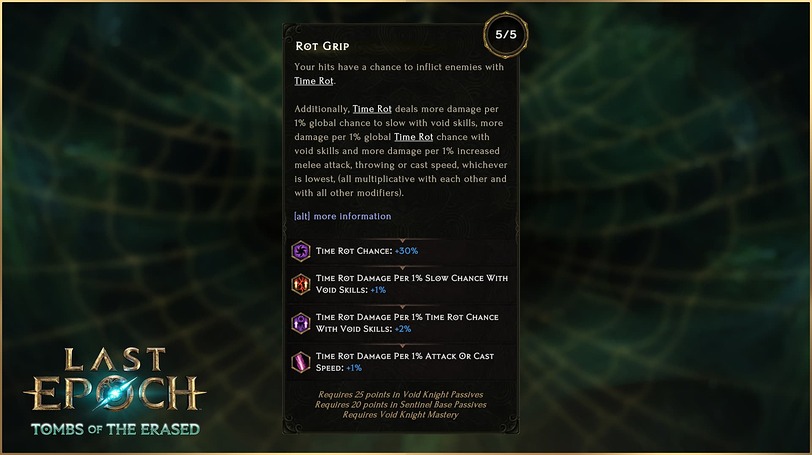 rotgrip1920×1076 109 KB
rotgrip1920×1076 109 KB
Passive Changes
With the Sentinel Rework, a total of 65 passives have been changed between all Masteries. That’s a few too many to cover in a Blog Post like this, so for the full details, you’ll have to wait for the Patch Notes on the 11th. For today, we’re going to cover some of the bigger new or changed nodes. While almost all of these passive changes are in Void Knight and Paladin, with Forge Guard recently getting attention, Forge Guard is still getting a very impactful new passive in Forgemaster’s Might.
Forgemaster’s Might
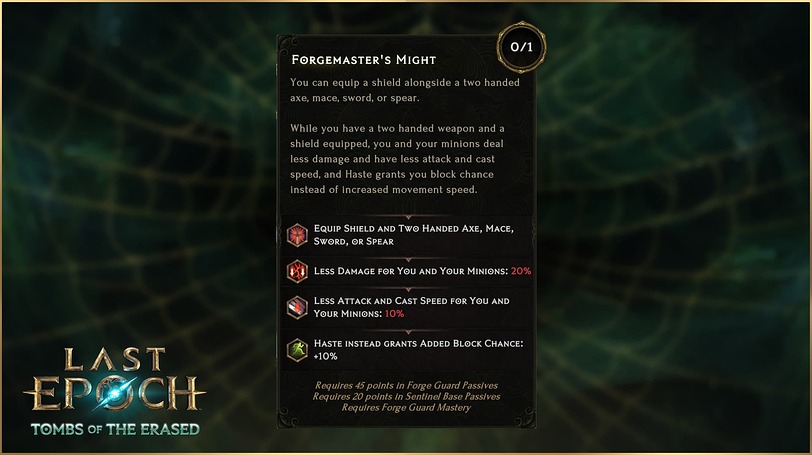 forgemastersmight1920×1076 109 KB
forgemastersmight1920×1076 109 KB
With Monument of Protection we introduced a “dual-wielding shields” option, the next logical step was wielding a two-handed weapon with a shield. While no current characters have four arms to dual-wield two-handed weapons, we do feel the Forge Guard’s mastery of weapons gives them enough of an edge to efficiently wield one with a single hand.
Sword of Rahyeh
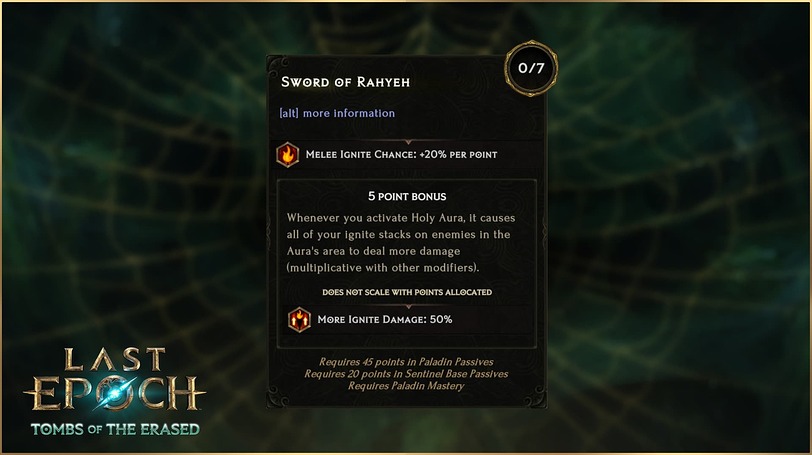 swordofrahyeh1920×1076 97.7 KB
swordofrahyeh1920×1076 97.7 KB
This Paladin capstone node found at the end of the passive tree now offers power to warrant its position as one of the final Paladin passive nodes. Not only offering a significant amount of Melee Ignite Chance per point, it also offers a threshold bonus granting a major boost to all ignite damage when you activate Holy Aura.
Holy Precision
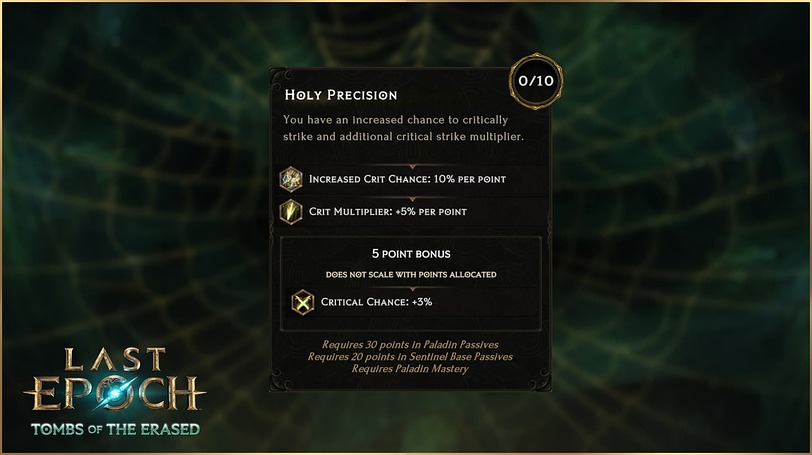 holyprecision1920×1076 95.6 KB
holyprecision1920×1076 95.6 KB
Holy Precision is a node which currently offers a lot of power, but is limited to Lightning Damage, greatly limiting its applicability. While the values for the node have been adjusted, its effects are now much more universal, and the benefits offered are still nothing to sneeze at, offering Added Critical Strike Chance with its Threshold bonus.
Woe
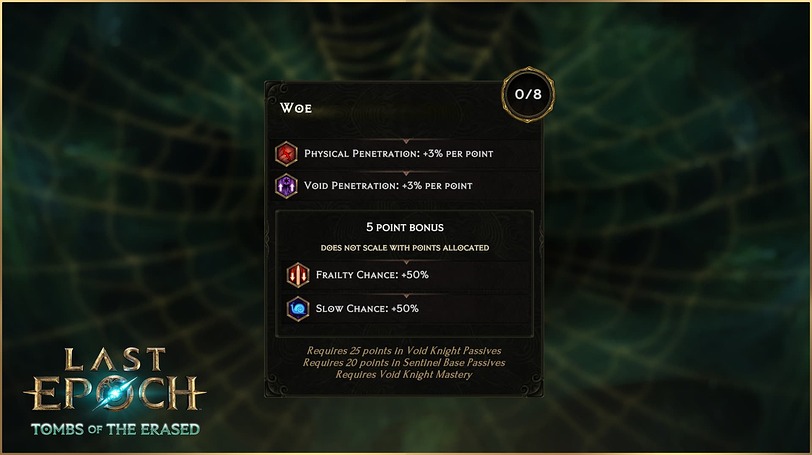 woe1920×1076 92.8 KB
woe1920×1076 92.8 KB
In theme with the Void Knight, the adjusted Woe node offers a Threshold bonus with Slow and Frailty Chance. Combine this with the altered Dread Form passive, which reduces slowing effects on you, and you’ll have much greater mastery over the passage of time for yourself and your enemies.
Abyssal Fluctuation
You deal zero damage while you’re dead. Abyssal Fluctuation offers a powerful and thematic method of damage reduction for the Void Knight, converting up to 50% of Elemental Damage Taken to Void Damage Taken and reducing all Void Damage Taken (including the converted damage).
 abyssalfluctuation1920×1076 84.3 KB
abyssalfluctuation1920×1076 84.3 KB
Skill Changes
Continuing with the theme of “too many changes to show in one Blog Post,” the Sentinel is also receiving changes to 22 of its 26 skills. As with passives, you’ll have to wait for the Patch Notes for the complete list of changes, but today we’ll touch on some of the skills receiving more significant changes.
Devouring Orb
Devouring Orb has received an adjustment to its base functionality, now passively dealing Void Damage over Time to enemies within its area of effect. This change helps Devouring Orb in more of a primary skill role, less dependent on other skills to trigger rifts.
Inside the Skill Tree, you’ll find many changes and even some entirely new nodes. Two of note being the new “All Consuming” node and the reworked “Abyssal Rush” node.
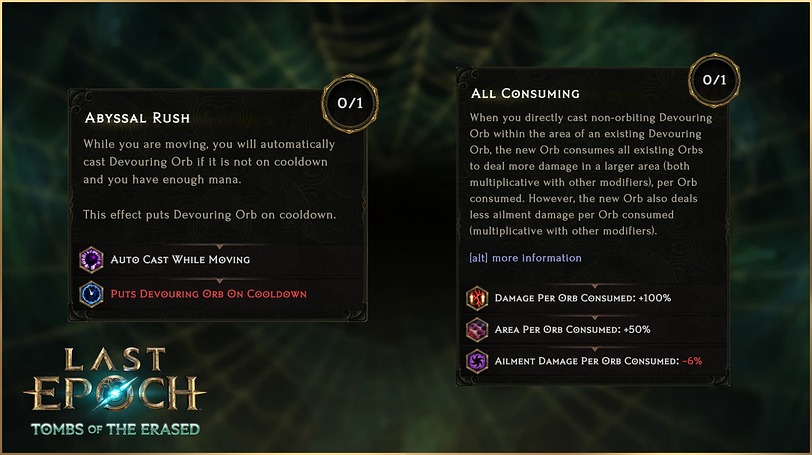 abyssalrush1920×1076 126 KB
abyssalrush1920×1076 126 KB
Javelin
While Javelin has had its Added Damage Effectiveness increased to 250% (from 200%), the biggest changes for Javelin can be found in its skill tree nodes. This includes Divine Fury no longer being incompatible with Siege Barrage. With both nodes allocated, each Javelin that rains down will create lightning spears. In addition, many nodes have received adjustments to provide more power to Javelin builds, as well as compensate for the Volatile Reversal changes.
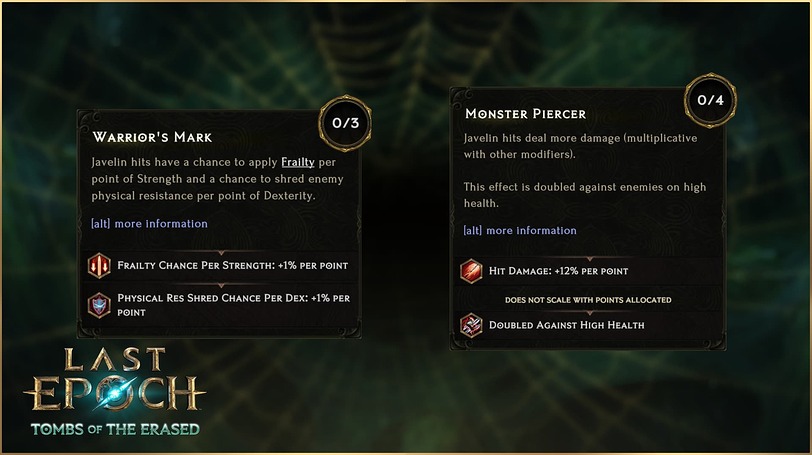 warriorsmark1920×1076 112 KB
warriorsmark1920×1076 112 KB
Multistrike
Multistrike is also receiving a number of numerical adjustments, along with one very big new node. With Bladestorm, your additional swords are able to consume mana and, in exchange, strike the same enemy. This makes Multistrike far more formidable against individual targets - if you can sustain the cost. Multistrike has also received a buff to its hitbox, making reliably landing those primary hits feel much smoother.
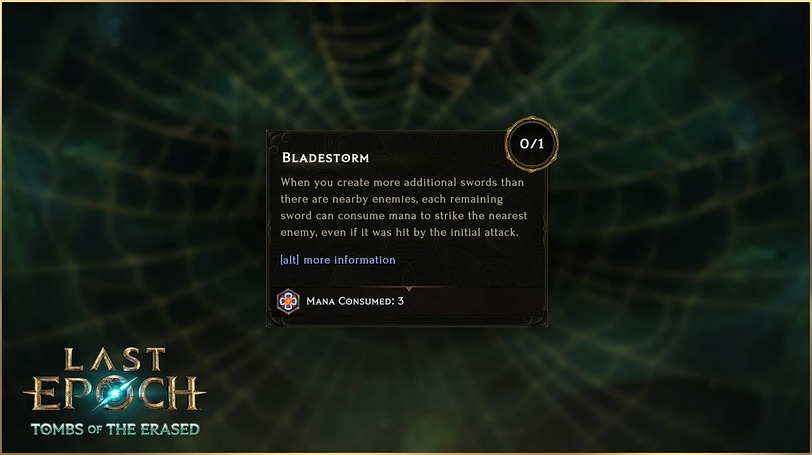 bladestorm1920×1076 82.8 KB
bladestorm1920×1076 82.8 KB
Shield Throw
Shield Throw is an ability that previously required a number of passive points to get it up and running as a primary skill. This is largely because of the long cooldown, which required a non-insignificant number of skill points to remove. Considering this was the style that was generally preferred for the skill, we’ve adjusted its base functionality to reflect this, removing the initial cooldown and reducing the cost.
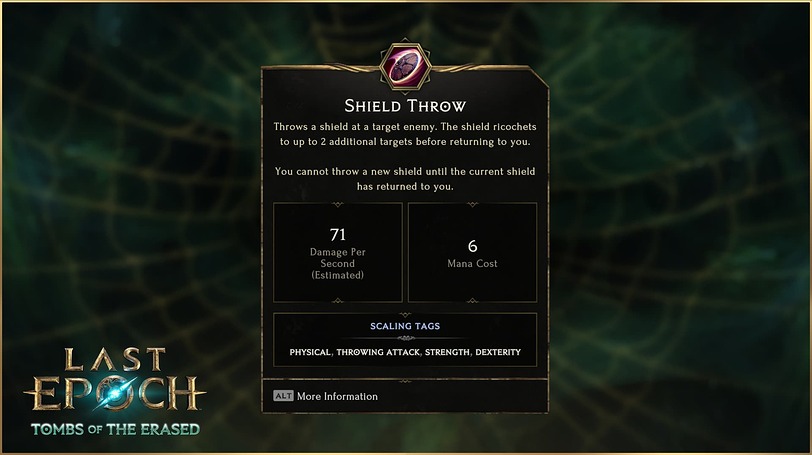 shieldthrow1920×1076 95 KB
shieldthrow1920×1076 95 KB
While it still requires the shield to return before throwing out a new shield, it now only costs a single skill point in the first ring of the tree to remove that restriction. Alternatively, you can add a cooldown to the skill and further specialize it to be able to ricochet to yourself and grant additional benefits with that. These changes free up skill points and, combined with other node changes throughout Shield Throw, make it a much smoother and more formidable skill.
Smelter’s Wrath
Smelter’s Wrath is receiving some fairly significant number changes and an important mechanical change. While many nodes on the tree are receiving some love, the Added Damage Effectiveness of Smelter’s Wrath is being increased to 600% (from 450%).
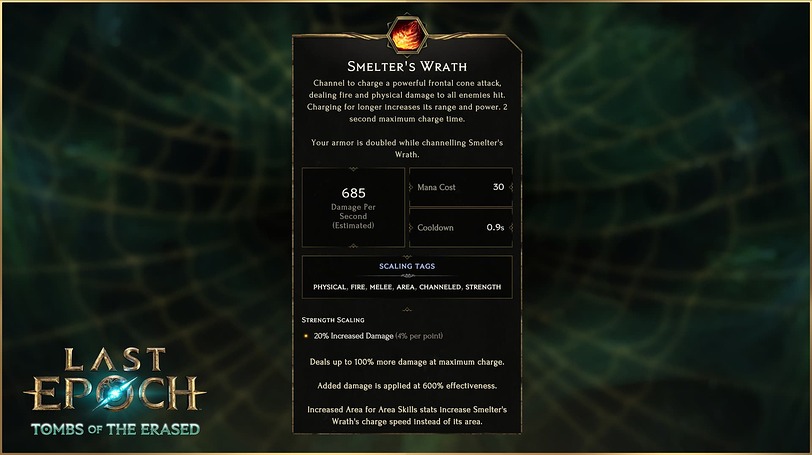 smelterswrath1920×1076 102 KB
smelterswrath1920×1076 102 KB
Mechanically, Smelter’s Wrath is being changed to now grant more damage based on charge, up to 100% more damage at maximum charge, from 50% more hit damage per second spent charging. This means that reducing your charge time will no longer reduce the benefit received from this effect. Effects in the tree that are “for each second channeled” remain unchanged.
Vengeance
The last skill we’ll be touching on today is Vengeance. With 28 lines of Patch Notes just for Vengeance Skill Tree changes, Vengeance has a new outlook on life in Season 2. This includes changes to Iron Blade offering a way to get it to a 100% chance on both Vengeance and Riposte hits, Forged Weapon generation, and full Fire and Void conversion options while keeping its highly defensive strengths. Like Multistrike, its base hitbox has been increased to help make striking with the attack feel smoother and more forgiving.
 abyssalretribution1920×1076 120 KB
abyssalretribution1920×1076 120 KB
Closing
There are so many more related changes we didn’t have an opportunity to show off in this post, but don’t worry, the Patch Notes are just around the corner. We look forward to seeing what kind of builds the community manages to create with the all-new Heartseeker, as well as the reworked Sentinel in Season 2: Tombs of the Erased, launching April 17th!
Be sure to stick around for more Pre-Patch Hype Week Blog Posts!
Hype to look forward to
- Endgame Itemization and other Balance changes (4/9)
- QoL & other game improvements inc. dungeons (4/10)